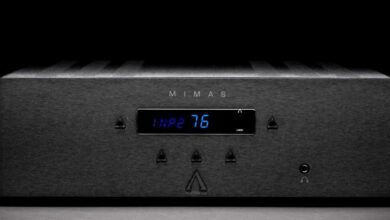iFi iCAN Luxurious Phantom Amplifier (Part I)
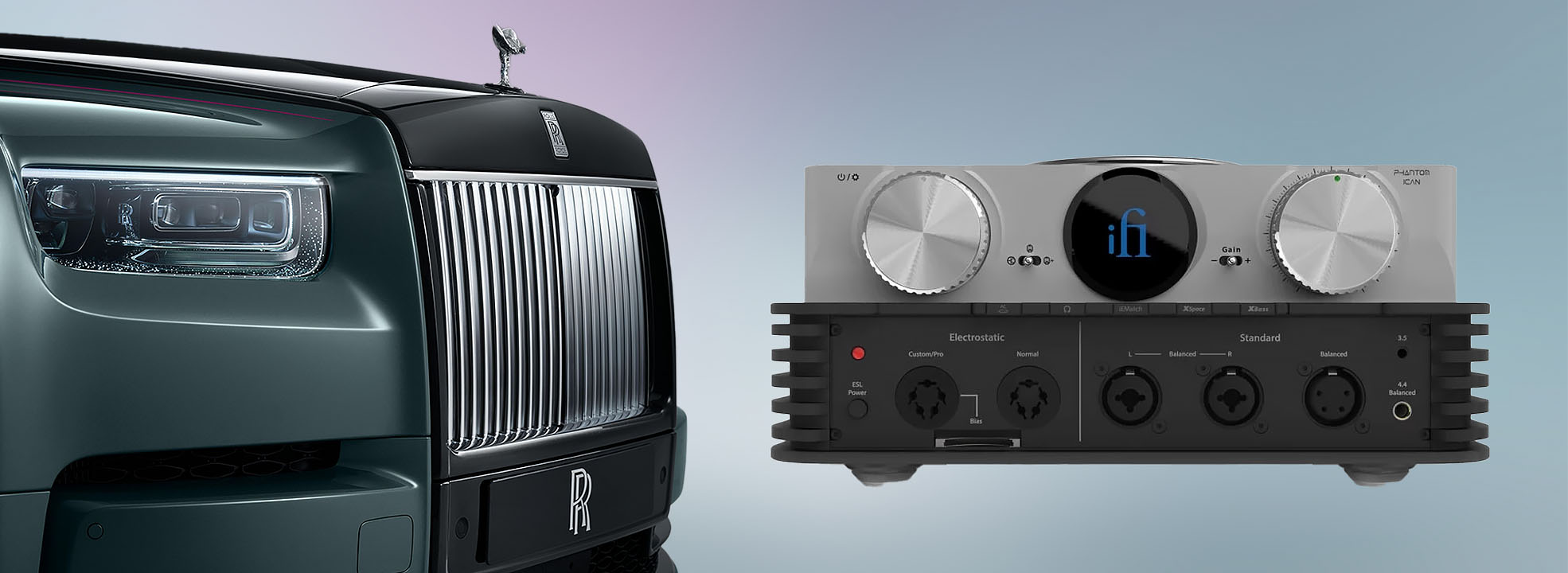
Legends are made through the pursuit of perfection.
I remember seeing a prototype of today’s subject in Munich last year. Being just a preview of an upcoming product, I only bothered a little to understand the design, which seemed quite striking; I needed to figure out what the final product attributes were and what was just a show-off, especially for Munich High-End 2023. What I saw was a strange mix of two-body structure, a transparent top plate, high-quality knobs, and an attractive round and colorful display. The latter was something that I recognized from the iFi Pro series, the iDSD Signature, and I was always fond of it. Ultimately, I made a mental note to follow up on when it will be ready for prime time.
Months passed, and I remembered about it last December when lovely friends from iFi’s local distributor – AV Store, reached out to ask me if I would want to listen and give my impressions on the iFi flagship headphone amplifier, the iCAN Phantom. I was surprised to hear the name, not connecting the dots for a few seconds.
The iCAN what? I asked. My caller answered that the Phantom is iFi’s new best and mighty headphone amplifier. And then it came back to me. I remembered the strange, intricate two-body product from Munich. So, it is a reality now, I told myself while opening the iFi website. Then I saw it again, and it looked exactly like it was in the preview phase. That is bold, isn’t it? To keep all those peculiar attributes intact is a courageous move. I kept staring at the picture and had mixed feelings; I was unsure where to put it in my designer mind. There were parts I loved and some I did not understand. Why? was a returning question. Why did it look like two amplifiers stacked on top of each other? Why it was built in two colors like this was obviously a stubbornness to exaggerate the two-body aspect. Why the smoky glass top cover? Why is the top-rounded metal piece with the large iFi logo there? It was such a collection of exciting design ideas mixed incomprehensibly, the kind of object that can not strike you as ugly because it is not, or bland beautiful because it is not that either. It forces you to keep looking, trying to understand, and deciphering meaning. You’ll keep staring at it, and you can not dismiss it with a move of your hand because it is so intriguing. I got some answers for some of the “whys,” and I will share them with you. For a few, I never got a reason. After using it for a few weeks, I put all that in the utterly personal character category as an immutable part of its being.
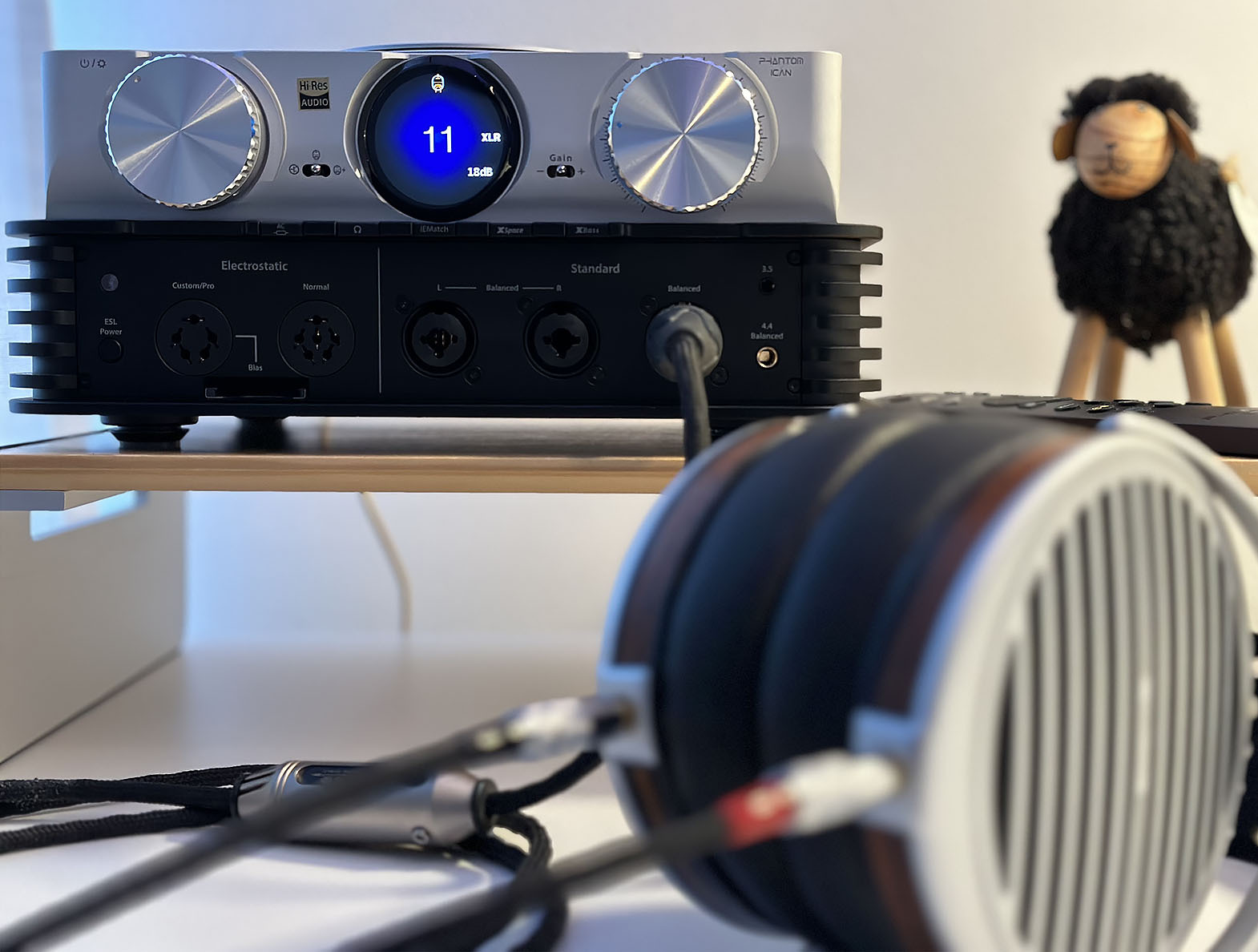
Later, I read online a comparison with Rolls-Royce’s iconic vehicle – Phantom. I laughed, thinking that this was a forced and too-easy proposition. Curious, I searched for Rolls-Royce’s statement car in a Google image search. I understood a few visual clues, but mostly, reading about the car, I understood the connection from other perspectives.
The pinnacle Rolls-Royce Phantom Series II is a legendary maverick and icon of inimitable perfection.
Living with iCan Phantom for a while, I totally appreciated the myriad of capabilities. From the powerful engine to the luxury display and finishing, the Phantom is indeed a statement product. Even the proposal of building a mighty amplifier capable of driving any headphones, from dynamic to planar drivers and electrostatic breed, seems like the ultimate goal for the manufacturer. The amp strives to be your statement piece, the one and only you’ll ever need. Would you like some tubes in your life? Phantom will deliver it in glory. Would you like a headphone collection with attentively selected blends and characters? Your life will be easier; this amp will let you enjoy the experience without second thoughts. Would you like the well-known iFi flavors like XSpace and XBass? Of course, it is an iFi amplifier. It is an exclusive, very comfortable journey, like in a luxury car where you’ll have everything at your fingertip – from a glass of cold champagne to the perfect heated or cooled seats, a perfect cruise in cushioning comfort. Then, the comparison with Rolls-Royce’s Phantom is not a name-only driven one after all…
Indeed, iFi tried to deliver a pinnacle product, a luxury statement where nothing is left to desire. Their Pro iCAN Signature is another excellent example of a pursuit of perfection. This time around, they aimed higher. Let’s see in-depth if they succeeded.

Design & Build Quality
As controversial and striking as it is, the Phantom’s appearance is endorsed by its build quality. I now have some answers to the design decisions made by iFi.
The appearance of two units – it is, in fact, a single dual-level design. Its enclosure is sturdily constructed from aluminum, with the bottom layer sporting cable connections front and back and the top layer offering tactile controls and a colorful OLED display. Keeping the connection on the bottom black part and all the controls on the upper silver one is a conscious design decision, making much more sense once you learn the details.
The smoked glass panel on top – the flush-fitting semi-transparent panel enables you to see the amp’s circuitry and its glowing audio valves. And what a beautiful sight it is! The circular aluminum dome has a clear and intelligent purpose, containing circular aluminum vents to ensure the circuitry does not overheat.
When not used, the sockets at the front or back can be hidden by a neat aluminum panel that attaches magnetically. This panel also holds the data cards for the electrostatic bias voltage settings.
The iCAN Phantom also has an attractive, easy-to-use aluminum, high-quality remote control. It looks like the usual remote at first sight but is far from the usual plasticky bar that we are used to.

Overall, the build quality is beyond reproach. It is heavy, weighing 4.2 kg, and quite refined, especially with that lovely, perfectly rounded color screen. The front shows a large, comfortable grip volume control, a mute/input selector, and operation/mode switches. Everything feels well-built and perfectly finished with premium materials. It comes with iFi accomplished external power source iPower Elite, even if the Phantom has, in fact, a capacitive power supply, but on this a little later.
Exemplary build quality, sophisticated technology, unrivaled specification, and remarkable versatility, expertly engineered to drive every headphone type to its full sonic potential. From ultra-sensitive IEMs to the finest dynamic driver and planar magnetic headphones to the most power-hungry electrostatic designs, the iCAN Phantom promises a genuinely exceptional headphone experience – exquisitely tailored to the listener’s requirements.
Controls and Connectivity
Every connection is covered.
The iCAN Phantom supplies a wide array of balanced and single-ended connection options. The headphone outputs are at the front, with the source inputs and preamp outputs at the rear.
Here’s a summary of the rear connections available:
- Source inputs – 1x balanced XLR (L/R), 3x RCA (L/R)
- Headphone outputs – 1x 3-pin balanced XLR (L/R), 1x 4-pin balanced XLR, 1x 4.4mm balanced, 1x 6.3mm (positive phase), 1x 6.3mm (inverted phase) and 1x 3.5mm (includes S-Balanced technology to cut distortion by 50 percent)
- Electrostatic headphone outputs – 1x 5-pin normal bias, 1x 5-pin custom bias
- Preamplifier outputs – 1x balanced XLR (L/R), 1x RCA (L/R)
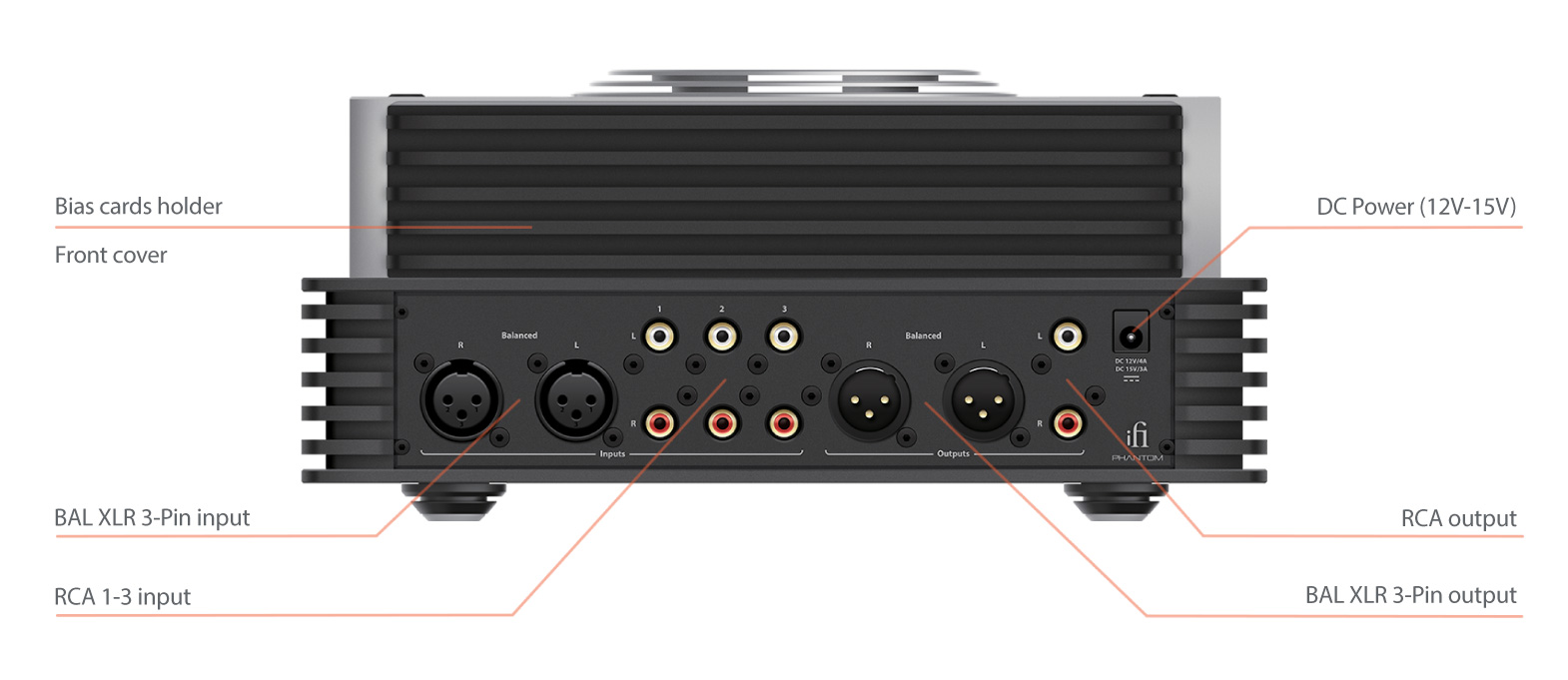
iFi Nexis – network-connected control
The iCAN Phantom is the first product to incorporate iFi Nexis, a module with an app to provide a comprehensive, scalable network-connected control system.
The features that Nexis offers will grow over time. At launch, the Nexis app enables your Android or iOS device to act as a ‘super remote control’ for the iCAN Phantom, providing access to additional features inaccessible via the amp’s fascia or standard remote control.
The app can display diagnostic information and allow the user to monitor the iCAN Phantom’s operational condition in real-time – for example, voltages, the condition and projected life span of the vacuum tubes, and so on. It can also apply over-the-air updates to the iCAN Phantom’s firmware, downloading and installing update files via your home Wi-Fi network.
iFI promises on their website:
As the number of Nexis-compatible iFi devices grows and the app’s functionality expands, a network-connected iFi ‘ecosystem’ will develop – one app for all your requirements, like a concierge service for iFi customers. It will enable additional software-driven functionality to be delivered and shared across existing iFi devices, as well as providing a direct technical support service and even potentially an online store within the app.
The front upper part of the amp offers two large knobs, left and right, and an even larger perfect circular color screen in the middle. The Left knob handles the Power / Mute / Input and Menu triggers. The right knob is the analog control dial. Between the left/right knobs and the screen, we can find the selectors for Operation Mode (solid state, Tube, and Tube +) and the Gain selector – both selectors are triggers for changing the states, and it will keep its middle position after the status change. The display reflects all the changes.
The black part with output connectivity from the front provides a lot of connections together with the Electrostatic Headphone ON/OFF:
- Electrostatic Custom/Pro headphone output
- Normal Bias ESL Headphone output
- Balanced XLR separate left and right XLR outputs
- Balanced XLR headphone output
- Balanced 4.4mm headphone output
- Unbalanced 3.5mm headphone output
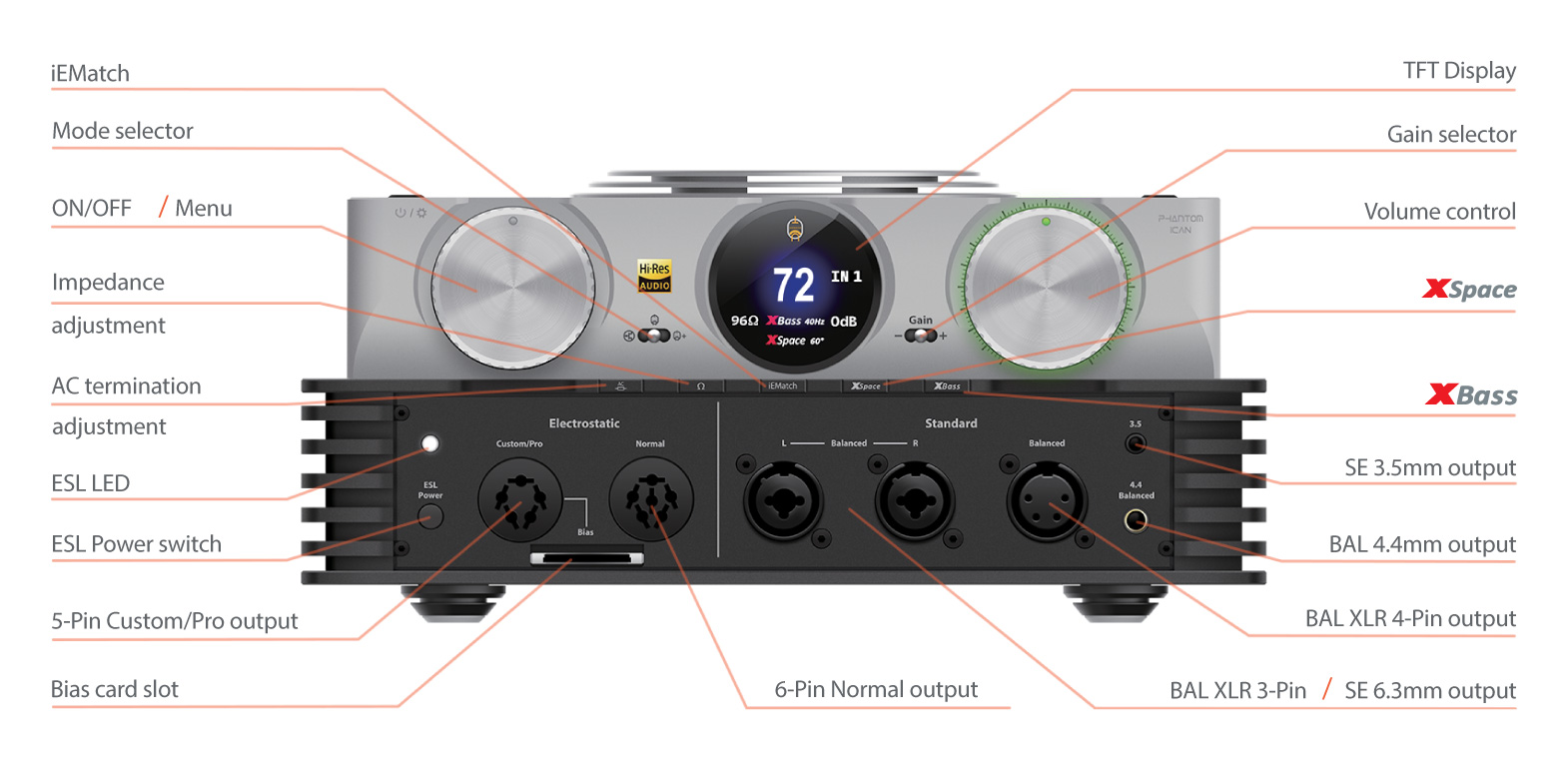
It is one of the few headphone amplifiers showing separate balanced XLRs for both channels. I only encountered that in some exquisite and very powerful amplifiers, one of them being a top-of-the-line Trafomatic Primavera valve amplifier. The iFi wanted to make sure to get everything here; best comfort is not an option; it is fully included.
I will not tackle the electrostatic cards and the electrostatic settings part here. That will come in the second part of this review, dedicated entirely to the electrostatic breed.
Display Settings
I will only dwell on some display settings; the menu is relatively straightforward, and I want to give you the pleasure of discovering it for yourself in case this piece of glorified audio tech tempts you.
I will only tell you that you get proper feedback on the display with icons and colors. I loved the tube-setting status, and you can even check the tube runtime expressed in hours. Even if you do not have to worry about the tube life as being rated to +10.000 hours, it is still a nice feature.
Many convenience settings are also present: Auto-off-setting, Zero Mute volume at startup or when changing the source, Operation Mode, Bias voltage settings, Volume, Impedance, XBass and XSpace adjustments, iEMatch, and Gain.
Another way of showing the operating status is by the colorful volume light ring, which changes color based on the system status – warming-up, solid-state, or tube/tube + operating modes.
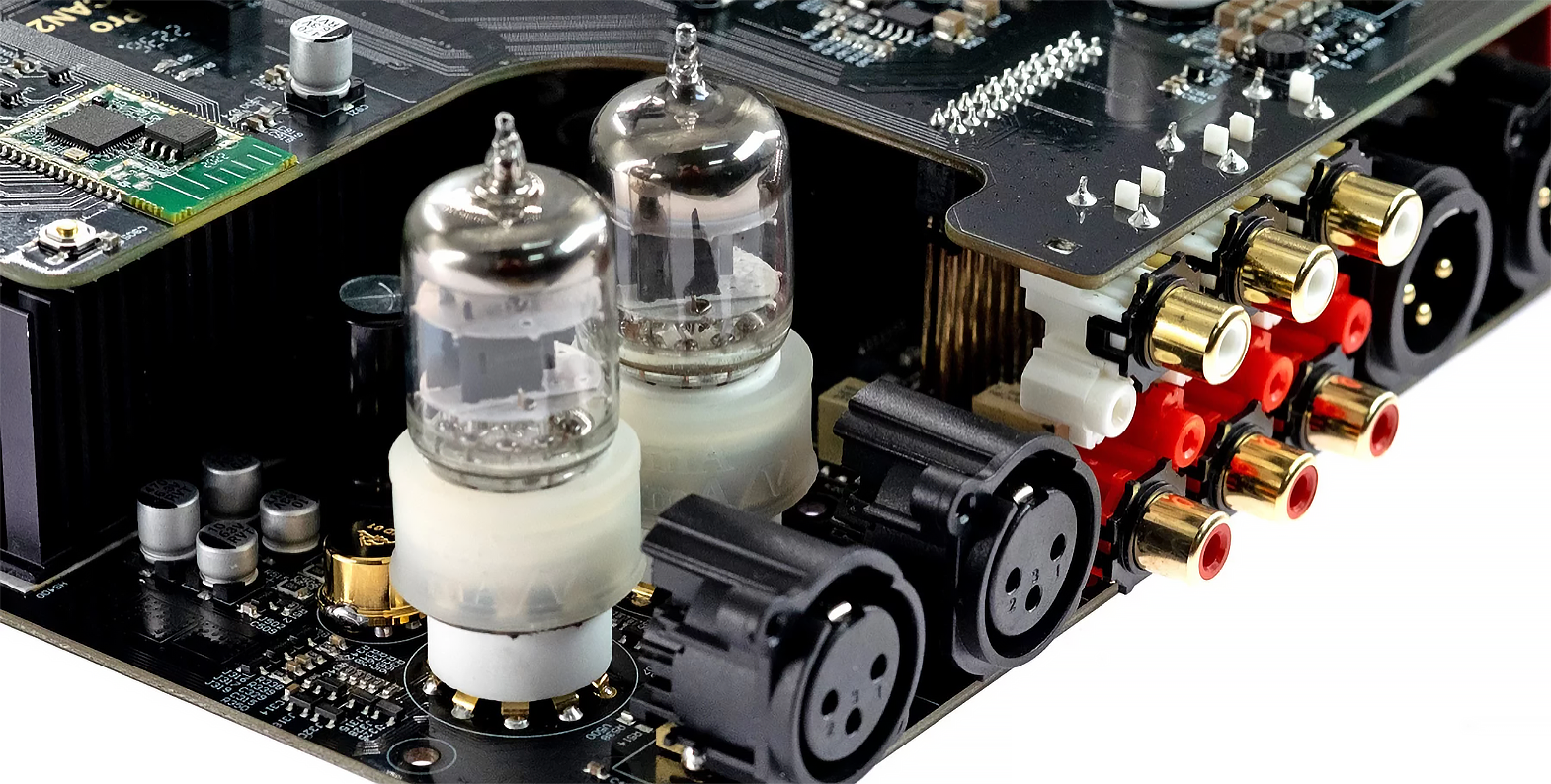
Under the Hood
As you can imagine, a lot is happening under the Phantom’s hood, being such a Swiss knife of an amplifier/preamplifier. The iCAN Phantom also performs as a high-end preamplifier – to feed a power amp and speakers (or powered speakers) – enabling headphone and speaker listening to be combined in a single high-performance audio system.
A tale of two input stages
The iCAN Phantom sports two input stages – one valve/tube-based, the other solid-state – enabling the user to switch between the two in real time. It is like having three amplifiers, each with a different sonic presentation. Solid-state offers pace and immediacy. Tube mode adds fluidity and a free-breathing dynamic quality. Tube+ accentuates the sonic influence of the valves, delivering a spellbinding romantic warmth that may suit, for example, acoustic and vocal musical styles. But let’s go deep into sonic characteristics a little down the road.

The fully discrete Class A solid-state input stage uses J-FETs. At the same time, the all-valve Class A circuit features a hand-selected, computer-matched pair of General Electric 5670 tubes, a premium variant of the 6922 tubes. This stage has two user-selectable modes – Tube and Tube+. The latter minimizes overall loop gain and thus negative feedback, giving a different trade-off between the tube’s natural harmonics and the transient performance.
Capacitive battery power supply
The iCAN Phantom’s capacitive battery power supply, initially developed for the Pro iESL, is intrinsic to its high level of performance. Rather than relying on a mains-powered switched-mode step-up circuit, a large battery of film capacitors rated at 1,000V DC is charged and occasionally topped up using AC mains power. This virtual battery pack’ delivers pure DC power, utterly free from all AC and switching noise – the perfect high-voltage supply for electrostatic headphones.
Balanced circuit design
It has long been considered a righteous path to audio excellence in high-end amp design, but the term ‘balanced’ is used differently and does not always mean the same thing. The iCAN Phantom takes balanced circuit design to the extreme – fully differential from input to output, minimizing noise and crosstalk in the signal path for ultimate sonic purity.
Essentially, a ‘fully differential’ circuit design – or True Differential Balanced, as iFi calls it – means that each channel (left and right) is fully separated in the circuit design, and each of these channels has two separate signals of equal level but opposite polarity (positive and negative). This requires four separate amp circuits, two for the left channel and two for the right channel – much more costly and complex to implement than single-ended circuit designs, but the sonic dividends are hugely worthwhile.
The iCAN Phantom’s True Differential Balanced circuitry is coupled to a volume control with six decks – two decks for each channel (positive and negative)- with the final two decks used to monitor the volume control operation. The motorized volume control potentiometer is custom-made by ALPS in Japan and is of exceptional quality.

PPCT (Pinstripe Permalloy Core Transformer)
Transformer quality is critical to sound quality, which is why the iCAN Phantom incorporates a custom-made PPCT (Pinstripe Permalloy Core Transformer). These include a GOSS/Mu-Metal hybrid core and complicated multi-section winding with vertical and horizontal sectioning, using an extremely thin wire that is hand-wound with great precision. This transformer can have extensive bandwidth, ultra-low distortion, and perfect linearity.
Test Equipment
I replaced the Trafomatic Primavera in my chain with the iCAN Phantom for reference purposes; the rest stayed the same. My headphone chain is as follows:
- Melco S100/2 data switch
- Melco N100 streamer
- Chord Hugo M Scaler
- Chord Dave DAC
- Trafomatic Primavera / iFi iCAN Phantom headphone amplifier
The Phantom reserved his place in my hi-fi headphones battle station, integrating perfectly. I mentioned it already – for the first part of this review, I will describe the sound characteristics of my two planar headphones: Meze Elite and HiFiMAN Susvara. A second part will follow, and I hope to assess the electrostatic territory properly soon enough.
I will be honest here – I have no electrostatic headphones. The electrostats only partially concurred with me. I always found extraordinary planars like Susvara to have on-par technicalities and more impact and slam like any electrostatic I could hear. I am not saying that there isn’t an advantage of electrostatics, but I found it always marginal, and the loss in other chapters was more than the gain I got.
But I promise I will give it another chance, especially with the Phantom, which seems so capable with the dynamic and planar breeds.

Sound Performance
1. Sonic tailoring for the best fit
Adjustable gain
Three settings – 0dB, 9dB, and 18dB – enable the amp to match the connected headphones precisely. Unity gain (0dB) is helpful to ensure low noise with more sensitive headphones and IEMs. In contrast, the higher gain settings make the most of more challenging headphone loads, delivering excellent dynamic headroom.
IEMatch
This proprietary iFi circuit attenuates the output to suit high-sensitivity IEMs (in-ear monitors) better, removing potential background noise and increasing the usable volume range. This can be optionally applied to the 3.5mm and balanced 4.4mm outputs.
XBass analogue processing
This proprietary circuit can be engaged to enhance low frequencies, its sophistication enabling it to do so while maintaining bass definition and without muddying the midrange. This is useful with, for example, some open-back headphones that sound bass light; it ‘corrects’ the bass so that the listener hears low frequencies as the artist intended. The iCAN Phantom offers three XBass steps – 10Hz, 20Hz, and 40Hz – or it can be switched out of the signal path altogether.
XSpace analogue processing
Another proprietary analog processing mode, XSpace, is designed to enhance soundstage width and depth. The iCAN Phantom includes two XSpace matrices, one for headphones and the other for speakers, with automatic switching between the two. XSpace for Headphones compensates for the ‘in-head localization’ effect when listening to mixed music using speakers, widening the headphone soundstage to deliver a more spacious and speaker-like experience. XSpace for Speakers increases the width of the apparent soundstage beyond the width dictated by speaker placement. Both forms of XSpace feature multiple levels that may be selected according to preference or switched out of the signal path completely.

2. Preliminary sound impressions
Powerful amplification delivers great musical gratification.
The iCAN Phantom is a potent headphone amplifier, capable of delivering more than 15,000mW from its balanced outputs and more than 5,760mW from its single-ended outputs into 16 ohms. In terms of voltage, it can supply more than 27V into a 600-ohm load; when it comes to electrostatic headphones, it delivers up to 640V.
The iCAN Phantom’s capacitive battery power supply, initially developed for the Pro iESL and further enhanced here, is intrinsic to its high level of performance. Rather than relying on a mains-powered switched-mode step-up circuit, a large battery of custom-made film capacitors rated at 1,000V DC is charged and occasionally topped up using mains power. This ‘virtual battery pack’ delivers pure DC, utterly free of AC and switching noise – the ideal high-voltage supply for electrostatic headphones.
There is no hard-to-drive in Phantom’s vocabulary.
I started with HiFiMAN Susvara as being extremely curious to see all the power in action. I was satisfied and immediately sensed that Susvara was appropriately driven with enough power. It is about something other than the loudness levels but the proper slam and the natural presence and attack of the instruments. Susvara can be driven pretty loud by many amplifiers, but very few can reveal the true potential. In the first few seconds, I realized that Phantom was doing well even with those highly demanding players.
3. Resolution / Detail Retrieval
Susvara is quite the proper tool to assess the resolution; every time, delivering on par with the best electrostatics and, when properly driven, with a little more weight and impact to the sound. iCAN Phantom allows them to grasp complex mixes easily without ever sounding muddy. These headphones have great punch, and this amp doesn’t hold them back.
Being a resolution champion, Susvara can easily slip into the harsh territory and the job of keeping it in the natural and sweet arena. The different guitar lines are easily distinguishable, but there’s always a thick foundation from the drums and bass guitar; once again, this amp can handle whatever combo you throw at it and deliver superb sound.
Compared to the Pro iCAN Signature, the Phantom is another step up from iFi engineers. There is clearly a lower noise floor, and the detail retrieval is quite spectacular. For sure, the capacitors bank has a great deal to maintain the noise at a minimum and reveal greater resolution. The spectacular achievement is the delivery of the details in a civilized manner and with a bit of sweetness at the top end.
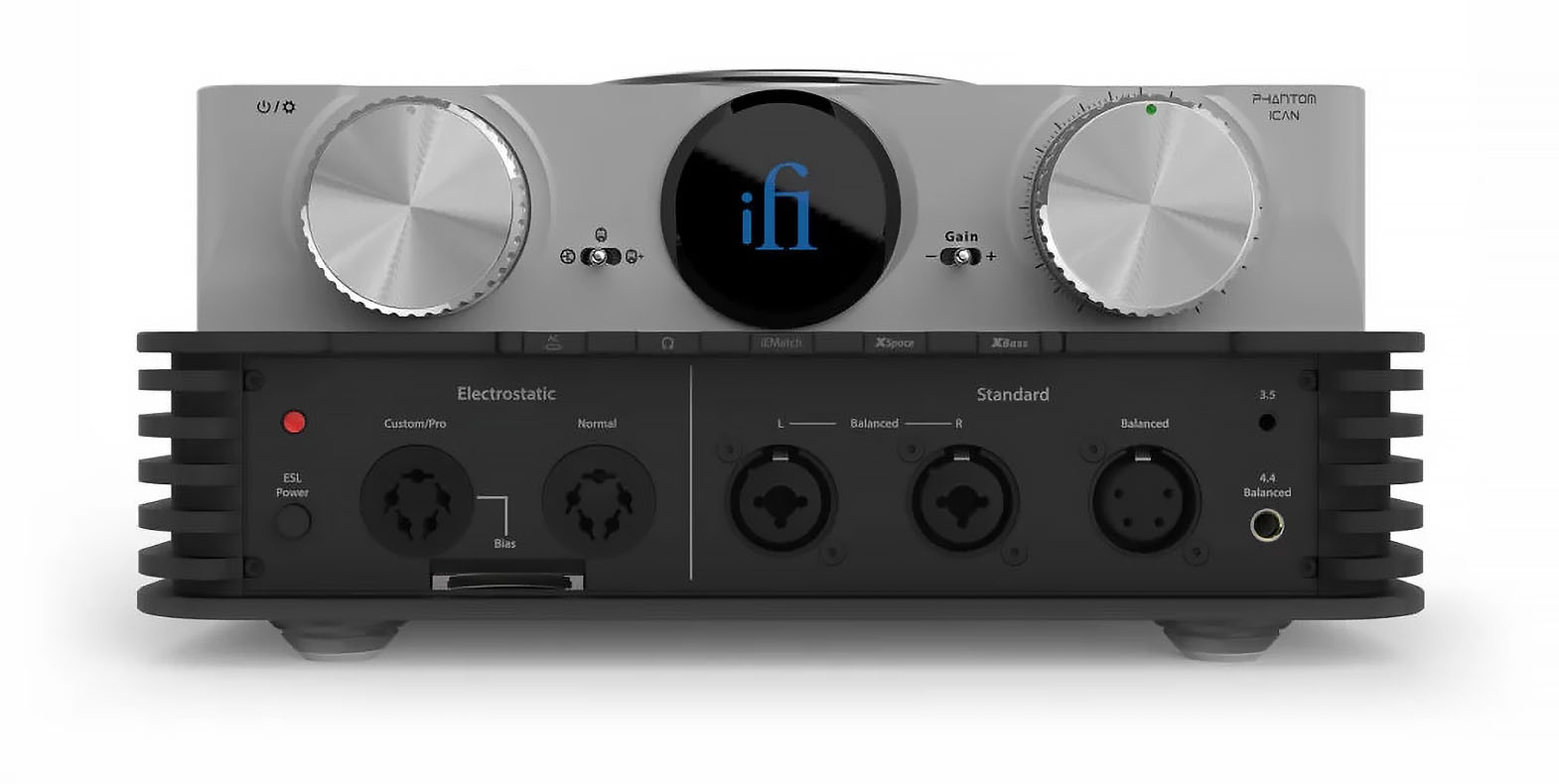
4. Dynamics & Transients
Chord Dave and M Scaler are undisputed champs in this category, and it just needs an educated companion to perform at its best. A good amp can make a great deal of difference. I compared the Phantom with my Trafomatic Primavera and did not need to catch up in this category. The financial gap between those two is huge anyway, so it can not be a fair comparison overall, but the Phantom keeps it up to the highest expectations.
Susvara even slammed more in the bass region, not necessarily more profoundly, but with a little more impact in the upper bass, which was unexpected. That is with the Tube mode activated. It did not lose composure, and the sound was warmer and more fluid. Going further in Tube + mode, the speed and the transients lose a bit of coherence, and the sound becomes softer and sometimes too much of a good thing. I discovered that the best equilibrium is achieved in tube mode, where the extra warmth is like a perfect cushion to sit in and feel the surroundings from a more admirable perspective.
In pure solid-state, the Phantom is as fast and dynamic as possible. The extra warmth added on top in Tube mode is complementary and welcomed.
5. Imaging and Soundstage
This is the part where any measurements come empty-handed. Any numbers showing the noise floor or distortion can not tell a complete story. Only the listening experience can provide a full picture. I compared the Phantom again with my amp in hand (well… at 30 kilograms, it is not quite handy) – the Trafomatic Primavera. I know, again, it is not a fair game. But still, that is why we need these reference systems to have a clear image of performance.
The imaging capabilities of iCAN Phantom do not disappoint at all. Precision given by the fast transients and good details are helping to score good points here. The soundstage can not compare with the giant in the room, but it is not constricted either. The tube mode helps with a warmer tonality, and the XSpace analog processing can compensate for the rest. Keeping these filters in the analog domain at their minimum setting provides the best results.
Even with Susvara, a monster always hungry for power, the imaging and soundstage are pretty good. Pairing it with something more human from the power perspective, like Meze Elite, a champion of soundstage, the difference registered with Primavera shrank a lot. Elite is not so picky regarding power, and it has a proper legacy in the soundstage domain. It sounded wide and precise, very close to the reference.
6. Bass, Midrange and Treble
Well, it is not a chapter that I like to write… As the title suggests, I find it hard to describe the frequency response in a decomposition mode. It is like trying to confirm what we can see on a measurement graph, which is not a correct picture. From my experience, the frequency response is highly interconnected, and any gain in one part of the spectrum will have consequences in another part. There is no winning without losing something; it is all about equilibrium. The music is not about highs and lows but about the flow, gaps, and emotions. I learned a good lesson recently from Lars Kristensen of Audio Group Denmark, confirming what I always felt but never put in the right words: “Music is about the pauses in between the sounds” – that is so true when you change the perspective. That is why I wouldn’t say I like the mathematical split of the frequencies and the pursuit of finding a definition here.
But I do not want to leave you empty-handed. I will try something different: I will try to describe the frequency response attributes through the filters of my two headphones involved in testing: HiFiMAN Susvara and Meze Elite. I hope to redeem some of my sins this way.
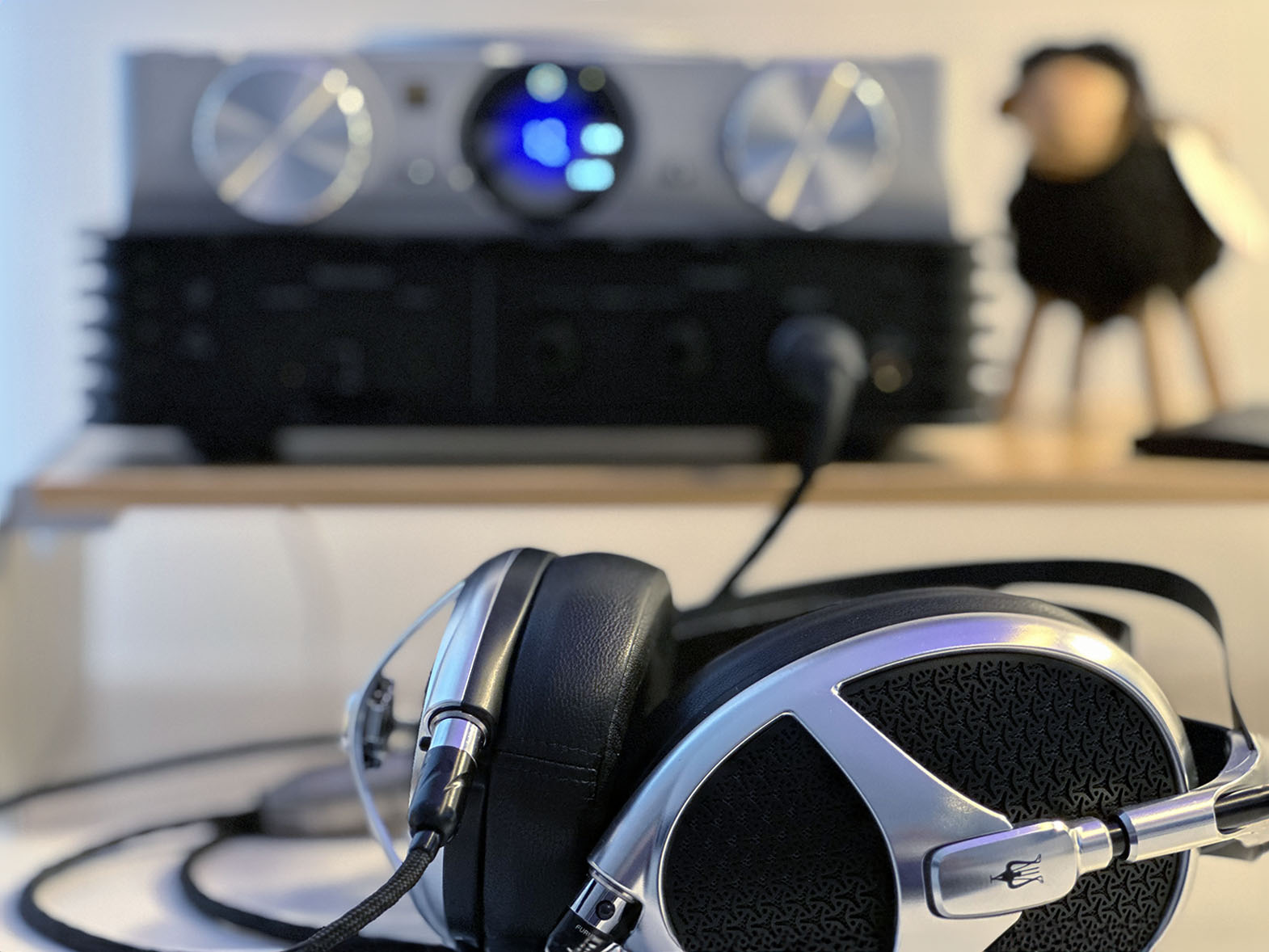
iCAN Phantom with Meze Elite
Finally, we reached the best moment of the whole experience. The pairing with Meze Elite was great, especially with little warmth of valves in Tube mode. Elite is a detailed headphone that stepped away considerably from the OG Empyrean. The high frequency can bite when paired with bright sources and amplifiers. That is not the case here. The upper-frequency range is well kept in control and, with the help of valves, is lingering on the sweetness side.
The mid-range was always the sweet spot of Meze house. Regarding the changes from Empyrean to Elite, they successfully preserved the mid-range presence, clarity, and emotion. The iCAN Phantom elevates the transparency of the mid-range and composes beautiful, organic, and textured voices. No harshness or edginess is present, and the valves will liquefy the smooth textures even more and add some spatiality, which we like to call a more 3D presentation with more depth and enhanced layering.
The bass is tight and punchy, well-defined, and never blurred. This is also the sidestep the Elite took from OG Empyrean. With Phantom, the bass is deep and rewarding, sometimes, to my surprise, a little punchier in the upper region than Primavera. I would not consider it elevated; the impact is a smidge more present and gratifying. The quality is there, without a doubt, and the pairing with the first setting on the valves is fantastic.
There is still a more open sound with Trafomatic, which is entirely understandable. That may be why the bass seems more condensed in the upper region and a little punchier there; Primavera is positioning the kick of the drums with more depth and atmosphere. It is bigger without a doubt, but Phantom is not far behind; the valves make a difference in recreating the same effect. Tube + will still clutter a bit and create a sound that is too dense with Elite. Too much of a good thing.

iCAN Phantom and HiFiMAN Susvara
With 15W in 16Ohm, the iCAN Phantom is no lady in disguise; the power muscle is in plain sight. I felt that immediately in the high-gain with Susvara. Hearing it properly driven is something to remember, and it will become very apparent when an amp is struggling. These headphones transform completely when the right quality power is present and a high current flows without restrictions. I heard Susvara on many amps, and very few can keep up with this power-eating monster.
The first impact of a proper amplifier for Susvara is felt in the upper frequency, which will no longer sound thin and light. The acoustic instruments gain weight, attack, and speed, and the naturalness of these headphones will awe you. I have never heard of such transparency, detail, and openness on headphones other than an adequately driven Susvara. Phantom is worthy of driving Susvara, without a doubt. I heard better with my Trafomatic Primavera, but let’s keep it real: for the size, money, and bulletproof encyclopedic options included, Phantom is a far healthier choice.
Susvara’s mid-range is not as lush as with the Elite; it is more real and not so intimate; it has a little distance, treated like any other instrument with proper weight, timbre, and naturalness. That is a good thing, and Susvara is definitely a more precise instrument trying to avoid a self-voice and letting only the original recording transpire. Phantom did an excellent job of keeping the original intent of the headphones. Even in Tube mode, the valves did not cripple the pure signature but added a touch of warmth and some spaciousness. Not quite like Trafomatic, this is the king of soundstage for these very hard-to-drive headphones.
The bass is another mark of a poorly driven Susvara. On a less competent amplifier, whatever loud you could drive the Susvara, even to the deafening levels, the slam lacks a lot, and the bass will be light and shy, never getting proper substance. It is an obvious diagnostic for insufficient high current and quality power. And you could hear that at the first kick of the bass. I was pretty impressed by how good and proper bass mustered to squish the Phantom from HiFiMAN’s top-of-the-line headphones.
A first conclusion, far from the end…
I am determined to follow up on this with another listening with electrostatic headphones. Phantom revealed a lot and set the bar very high with its dynamic/planar counterpart. I have great expectations now, and from what I’ve read lately, the electrostats gained some ground in resolving their “problematic” aspects from the past, like slam and bass weight. Part II of this review will follow, and I am already very curious.
Phantom proved worthy of a flagship symbol, and iFi surpassed their previous creations with a very accomplished product from every perspective. Phantom is full of options and promises and delivers in driving any headphones out there. It allows the genuinely passionate ones to manage a mixed headphone collection without a fuss; it is well-built and has nice flavors. Coming with the valve and discrete input stages, iFi’s well-known high-quality filters in the analog domain, silent capacitive power supply, and so many goodies seem like a no-brainer. It is priced fairly at 3,749 £ / 3,749 $.
I am grateful to the AV Store distributor in Romania for the chance to test it extensively. For Romania, you can check the iCAN Phantom here and always ask for advice and support from the highly professional shop team.
For the rest of the world, check your local iFi dealer.
I welcome your comments and feedback here, anytime. Til next time, let’s hear only about good stuff. Cheers.

